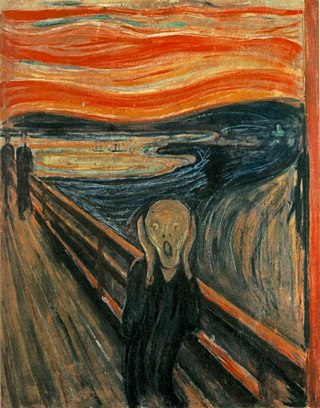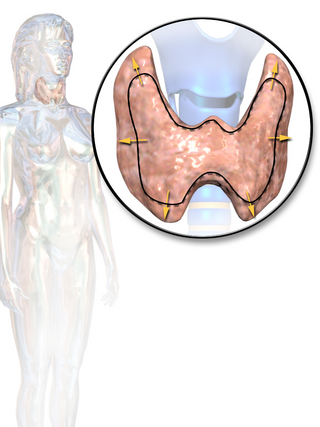Related Research Articles

Bipolar disorder, previously known as manic depression, is a mental disorder characterized by periods of depression and periods of abnormally elevated mood that each last from days to weeks. If the elevated mood is severe or associated with psychosis, it is called mania; if it is less severe, it is called hypomania. During mania, an individual behaves or feels abnormally energetic, happy or irritable, and they often make impulsive decisions with little regard for the consequences. There is usually also a reduced need for sleep during manic phases. During periods of depression, the individual may experience crying and have a negative outlook on life and poor eye contact with others. The risk of suicide is high; over a period of 20 years, 6% of those with bipolar disorder died by suicide, while 30–40% engaged in self-harm. Other mental health issues, such as anxiety disorders and substance use disorders, are commonly associated with bipolar disorder.
Bipolar I disorder is a type of bipolar spectrum disorder characterized by the occurrence of at least one manic episode, with or without mixed or psychotic features. Most people also, at other times, have one or more depressive episodes.

Hyperthyroidism is the condition that occurs due to excessive production of thyroid hormones by the thyroid gland. Thyrotoxicosis is the condition that occurs due to excessive thyroid hormone of any cause and therefore includes hyperthyroidism. Some, however, use the terms interchangeably. Signs and symptoms vary between people and may include irritability, muscle weakness, sleeping problems, a fast heartbeat, heat intolerance, diarrhea, enlargement of the thyroid, hand tremor, and weight loss. Symptoms are typically less severe in the elderly and during pregnancy. An uncommon but life-threatening complication is thyroid storm in which an event such as an infection results in worsening symptoms such as confusion and a high temperature; this often results in death. The opposite is hypothyroidism, when the thyroid gland does not make enough thyroid hormone.
Mania, also known as manic syndrome, is a mental and behavioral disorder defined as a state of abnormally elevated arousal, affect, and energy level, or "a state of heightened overall activation with enhanced affective expression together with lability of affect." During a manic episode, an individual will experience rapidly changing emotions and moods, highly influenced by surrounding stimuli. Although mania is often conceived as a "mirror image" to depression, the heightened mood can be either euphoric or dysphoric. As the mania intensifies, irritability can be more pronounced and result in anxiety or anger.

A mood stabilizer is a psychiatric medication used to treat mood disorders characterized by intense and sustained mood shifts, such as bipolar disorder and the bipolar type of schizoaffective disorder.

The thyroid, or thyroid gland, is an endocrine gland in vertebrates. In humans, it is in the neck and consists of two connected lobes. The lower two thirds of the lobes are connected by a thin band of tissue called the isthmus (pl.: isthmi). The thyroid gland is a butterfly-shaped gland located in the neck below the Adam's apple. Microscopically, the functional unit of the thyroid gland is the spherical thyroid follicle, lined with follicular cells (thyrocytes), and occasional parafollicular cells that surround a lumen containing colloid. The thyroid gland secretes three hormones: the two thyroid hormones – triiodothyronine (T3) and thyroxine (T4) – and a peptide hormone, calcitonin. The thyroid hormones influence the metabolic rate and protein synthesis and growth and development in children. Calcitonin plays a role in calcium homeostasis. Secretion of the two thyroid hormones is regulated by thyroid-stimulating hormone (TSH), which is secreted from the anterior pituitary gland. TSH is regulated by thyrotropin-releasing hormone (TRH), which is produced by the hypothalamus.

A sleep disorder, or somnipathy, is a medical disorder of an individual's sleep patterns. Some sleep disorders are severe enough to interfere with normal physical, mental, social and emotional functioning. Sleep disorders are frequent and can have serious consequences on patients’ health and quality of life. Polysomnography and actigraphy are tests commonly ordered for diagnosing sleep disorders.

A mood disorder, also known as an affective disorder, is any of a group of conditions of mental and behavioral disorder where a disturbance in the person's mood is the main underlying feature. The classification is in the Diagnostic and Statistical Manual of Mental Disorders (DSM) and International Classification of Diseases (ICD).

Anxiety disorders are a cluster of mental disorders characterized by significant and uncontrollable feelings of anxiety and fear such that a person's social, occupational, and personal functions are significantly impaired. Anxiety may cause physical and cognitive symptoms, such as restlessness, irritability, easy fatigue, difficulty concentrating, increased heart rate, chest pain, abdominal pain, and a variety of other symptoms that may vary based on the individual.

Attention deficit hyperactivity disorder (ADHD) is a neurodevelopmental disorder characterised by executive dysfunction occasioning symptoms of inattention, hyperactivity, impulsivity and emotional dysregulation that are excessive and pervasive, impairing in multiple contexts, and otherwise age-inappropriate.

A mood swing is an extreme or sudden change of mood. Such changes can play a positive part in promoting problem solving and in producing flexible forward planning, or be disruptive. When mood swings are severe, they may be categorized as part of a mental illness, such as bipolar disorder, where erratic and disruptive mood swings are a defining feature.

A mixed affective state, formerly known as a mixed-manic or mixed episode, has been defined as a state wherein features and symptoms unique to both depression and (hypo)mania, including episodes of anguish, despair, self doubt, rage, excessive impulsivity and suicidal ideation, sensory overload, racing thoughts, heightened irritability, decreased "need" for sleep and other symptoms of depressive and manic states occur either simultaneously or in very short succession.
In medicine and psychology, emotional lability is a sign or symptom typified by exaggerated changes in mood or affect in quick succession. Sometimes the emotions expressed outwardly are very different from how the person feels on the inside. These strong emotions can be a disproportionate response to something that happened, but other times there might be no trigger at all. The person experiencing emotional lability usually feels like they do not have control over their emotions. For example, someone might cry uncontrollably in response to any strong emotion even if they do not feel sad or unhappy.

Thyroid disease is a medical condition that affects the function of the thyroid gland. The thyroid gland is located at the front of the neck and produces thyroid hormones that travel through the blood to help regulate many other organs, meaning that it is an endocrine organ. These hormones normally act in the body to regulate energy use, infant development, and childhood development.
Bipolar disorder in children, or pediatric bipolar disorder (PBD), is a rare mental disorder in children and adolescents, and is controversial, mainly because adult bipolar medication can cause serious harm in childhood, so misdiagnosis is problematic. PBD is hypothesized to be like bipolar disorder (BD) in adults, thus is proposed as an explanation for periods of extreme shifts in mood called mood episodes. These shifts alternate between periods of depressed or irritable moods and periods of abnormally elevated moods called manic or hypomanic episodes. Mixed mood episodes can occur when a child or adolescent with PBD experiences depressive and manic symptoms simultaneously. Mood episodes of children and adolescents with PBD deviate from general shifts in mood experienced by children and adolescents because mood episodes last for long periods of time and cause severe disruptions to an individual's life. There are three known forms of PBD: Bipolar I, Bipolar II, and Bipolar Not Otherwise Specified (NOS). Just as in adults, bipolar I is also the most severe form of PBD in children and adolescents, and can impair sleep, general function, and lead to hospitalization. Bipolar NOS is the mildest form of PBD in children and adolescents. The average age of onset of PBD remains unclear, but reported ages of onset range from 5 years of age to 19 years of age. PBD is typically more severe and has a poorer prognosis than bipolar disorder with onset in late-adolescence or adulthood.

Obsessive–compulsive disorder (OCD) is a mental and behavioral disorder in which an individual has intrusive thoughts and feels the need to perform certain routines (compulsions) repeatedly to relieve the distress caused by the obsession, to the extent where it impairs general function.
An anxiety threshold is the level of anxiety that, when reached, can affect a person's performance. Anxiety is an emotion, similar to fear, that can be created by insecurities in one's abilities, concerns for the future, such as financial or situational circumstances, or past memories of frightening experiences. Anxiety can affect all age groups and if fears are irrational, it may cause mental disorders. An individual's anxiety threshold can be measured by the amount of anxiety consistently manifested from situation to situation.
The following outline is provided as an overview of and topical guide to bipolar disorder:
References
- ↑ "Amphetamines". Archived from the original on 2008-07-21.
- ↑ "Hypothyroidism: Symptoms and Treatments of Hypothyroid Disease - Part 1: Introduction, Causes, and Symptoms of Hypothyroidism". Archived from the original on 2014-11-12. Retrieved 2014-11-11.
- ↑ "How to Stop Racing Thoughts From Anxiety". calmclinic.com. Calm Clinic. 2014. Archived from the original on November 11, 2014. Retrieved November 7, 2014.
- ↑ Fraser, Michael (2014). "Obsessive Compulsive Disorder". Michael Fraser, Ph.D. TherapySites. Archived from the original on November 29, 2014. Retrieved November 11, 2014.
- ↑ Katz, Marina (February 20, 2012). "Panic Disorder". webMD. webMD. Archived from the original on November 11, 2014. Retrieved November 11, 2014.
- ↑ Tartakovsky, Margarita (2011). "How to Halt and Minimize Panic Attacks". PsychCentral. PsychCentral. Archived from the original on November 29, 2014. Retrieved November 11, 2014.
- ↑ Torpy, Janet M.; Burke, AE; Golub, RM (2011). "Generalized Anxiety Disorder". JAMA. 305 (5): 522. doi: 10.1001/jama.305.5.522 . PMID 21285432.
- ↑ Mayo Clinic Staff (September 25, 2014). "Generalized Anxiety Disorder". MayoClinic. Mayo Foundation for Medical Education and Research. Archived from the original on November 11, 2014. Retrieved November 11, 2014.
- ↑ "What is bipolar disorder?". National Institute of Mental Health. NIH. 2014. Archived from the original on August 5, 2018. Retrieved November 11, 2014.
- ↑ Frye, Mark (May 31, 2009). "Racing thoughts can be sign of mood, anxiety disorder". Chicago Tribune. Mayo Clinic. Archived from the original on November 19, 2014. Retrieved November 11, 2014.
- ↑ "Amphetamine". drugs.com. Cerner Multum. April 12, 2009. Archived from the original on November 11, 2014. Retrieved November 11, 2014.
- ↑ Keedle, Jayne (October 30, 2010). "ADHD Can Affect Adults Too". timesunion. Hearst Newspapers. Archived from the original on November 29, 2014. Retrieved November 11, 2014.
- ↑ Quinn, Patricia (May 10, 2014). "ADHD Medication Chart". WebMD . Archived from the original on November 16, 2014. Retrieved January 16, 2024.
- ↑ Vega, Charles (March 26, 2008). "Stimulant Improves Sleep in Adult With ADHD". Medscape. Medscape. Archived from the original on October 13, 2019. Retrieved August 7, 2019.
- ↑ "Hyperthyroidism (overactive thyroid)". MayoClinic. Mayo Foundation for Medical Education and Research. 2014. Archived from the original on November 12, 2014. Retrieved November 11, 2014.
- ↑ Jamrog, Karen A. (May 2013). "Treating and Understanding Thyroid Disease". nhmagazine. McLean Communications. Archived from the original on November 29, 2014. Retrieved November 11, 2014.
- ↑ "Facts & Statistics". Anxiety and Depression Association of America. ADAA. 2014. Archived from the original on October 26, 2014. Retrieved November 10, 2014.
- ↑ Baer, Lee (2001). The Imp of the Mind: Exploring the Silent Epidemic of Obsessive Bad Thoughts . New York: Dutton. ISBN 0-525-94562-8.